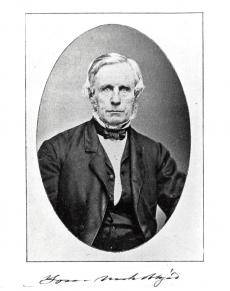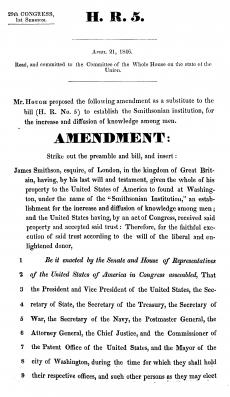 What do you do when you're trapped in a legislative logjam? That was the dilemma that proponents of creating a Smithsonian faced in the spring of 1846. The United States had been notified by officials in England of James Smithson's unusual bequest in 1835. In 1836, the US Congress voted to pursue the bequest in the English Court of Chancery, and his estate was awarded to the US in 1838. But after that, momentum to create the Institution faded. President Martin Van Buren solicited ideas from educational leaders, but Congress was not in a terribly productive mode – indeed the first filibuster was held in 1841 from February 18 until March 11. Bills were introduced to create a Smithsonian as a national university, mechanics' institute, ladies seminary, teachers' training institute, botanic garden, astronomical observatory, national library, scientific research institute, and even a museum! Charlatans who were eager to get their hands on the $500,000 offered many other ideas. Former President John Quincy Adams, then a representative in Congress, focused on protecting "as from a rattlesnake's fang, the fund and its income, forever from being wasted and dilapidated in bounties to feed the hunger or fatten the leaden idleness of mountebank projectors and shallow worthless pretenders to science."
What do you do when you're trapped in a legislative logjam? That was the dilemma that proponents of creating a Smithsonian faced in the spring of 1846. The United States had been notified by officials in England of James Smithson's unusual bequest in 1835. In 1836, the US Congress voted to pursue the bequest in the English Court of Chancery, and his estate was awarded to the US in 1838. But after that, momentum to create the Institution faded. President Martin Van Buren solicited ideas from educational leaders, but Congress was not in a terribly productive mode – indeed the first filibuster was held in 1841 from February 18 until March 11. Bills were introduced to create a Smithsonian as a national university, mechanics' institute, ladies seminary, teachers' training institute, botanic garden, astronomical observatory, national library, scientific research institute, and even a museum! Charlatans who were eager to get their hands on the $500,000 offered many other ideas. Former President John Quincy Adams, then a representative in Congress, focused on protecting "as from a rattlesnake's fang, the fund and its income, forever from being wasted and dilapidated in bounties to feed the hunger or fatten the leaden idleness of mountebank projectors and shallow worthless pretenders to science."
 Sometimes it is good to have a fresh perspective, and in 1845, William Jervis Hough (1795 –1869) was elected to the US Congress to represent the 23rd district of New York. He served only one term in Congress, but forever altered the history of the United States through his interest in James Smithson's peculiar bequest. He reviewed the lack of progress thus far and offered an amendment to House Resolution 5, to found a Smithsonian Institution. To gain support for his amended bill, he put in a little something for the different advocates: a library, a museum, an observatory, and a scientific research laboratory. The only thing that was left out was the first idea – a national university. The bill futher stated that the trust organization created would be governed by a board of regents with both public officials and private citizens. All three branches of government – the executive, legislative and judiciary would be represented on the board. On August 10, 1846, the bill finally passed both houses of Congress with a vote of 85 to 76 and was signed into law by President James K. Polk the same day.
Sometimes it is good to have a fresh perspective, and in 1845, William Jervis Hough (1795 –1869) was elected to the US Congress to represent the 23rd district of New York. He served only one term in Congress, but forever altered the history of the United States through his interest in James Smithson's peculiar bequest. He reviewed the lack of progress thus far and offered an amendment to House Resolution 5, to found a Smithsonian Institution. To gain support for his amended bill, he put in a little something for the different advocates: a library, a museum, an observatory, and a scientific research laboratory. The only thing that was left out was the first idea – a national university. The bill futher stated that the trust organization created would be governed by a board of regents with both public officials and private citizens. All three branches of government – the executive, legislative and judiciary would be represented on the board. On August 10, 1846, the bill finally passed both houses of Congress with a vote of 85 to 76 and was signed into law by President James K. Polk the same day.
Hough served on the first Board of Regents, as did John Quincy Adams, ensuring that the fledgling institution got off to a good start. Hough also served on the building committee for the Smithsonian Castle. But his congressional career was short-lived. In 1846, the State of New York passed a new constitution setting aside all previous election results, and after the electoral melee of 1847, Hough returned to private law practice until his death in 1869. Hough's Smithsonian bill contained everything but the kitchen sink – a classic American political compromise – but it did the trick!
Related Resources
- Legal History of the Smithsonian, Smithsonian Institution Archives
- From Smithson to Smithsonian: The Birth of an Institution, online exhibition, Smithsonian Institution Libraries
Related Collections
- Record Unit 7061 - William Jervis Hough Papers, 1846-1847, 1896-1901, Smithsonian Institution Archives
Produced by the Smithsonian Institution Archives. For copyright questions, please see the Terms of Use.

Leave a Comment